Samsung QE75QN900A Review
One of the most cutting-edge LCD TVs ever
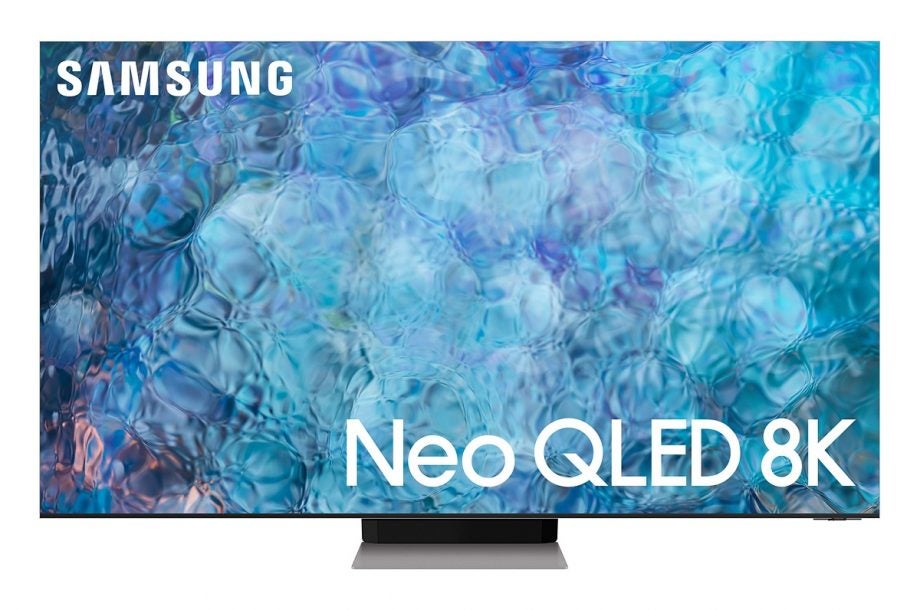

Verdict
By adding new mini-LED lighting and nearly 2000 dimming zones to an 8K resolution, Samsung’s already impressive backlighting and QLED technologies serve up arguably the most cutting-edge TV we’ve ever seen.
Pros
- Sensational HDR picture quality
- Excellent gaming features and performance
- Spectacular design
Cons
- Hard on the bank balance
- Native 8K content remains elusive
- Aggressive dimming of very small bright objects
Key Features
- Native 8K resolutionThe screen carries four times as many pixels as a 4K panel
- Mini-LED backlightingUses smaller LEDs behind the screen to give control over light
- Eden Smart systemSamsung’s proprietary smart system
- Object Tracking SoundSpeakers around each edge of the screen combine to make sound effects appear to be coming from exactly the right place on the screen
- 4K/120Hz, VRR and ALLMThe latest gaming features are all covered by the 75QN900A’s HDMI ports
Introduction
We’ve already been treated recently to a spectacular demonstration of what the LCD TV world’s new mini-LED technology can do in the shape of Samsung’s flagship 4K TV for 2021, the 65QN95A.
However, it turns out that this was just the start of Samsung’s mini-LED ambitions. Sat imposingly on our test benches is a 75-inch Samsung TV, the 75QN900A, which combines an 8K resolution with mini-LED lighting. It’s backed up by more than twice as many separate backlight dimming zones as featured on the 65QN95A – and the results are jaw-dropping.
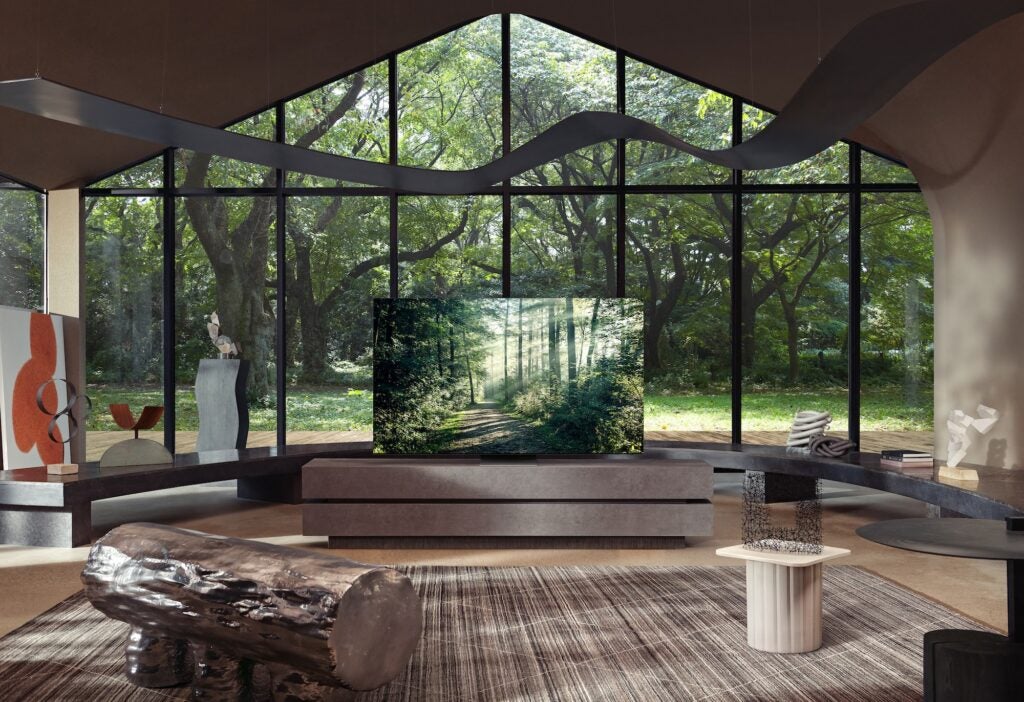
Availability
- UKRRP: £6999
- USARRP: $5799.99
- EuropeRRP: €7499
- CanadaRRP: CA$9499.99
At £6999, the QE75QN900A will put a rather large hole in your wallet. To put it in perspective, you can get LG’s 77-inch 4K OLED77C1 TV for just £3999 at the time of writing.
Inevitably, this puts a lot of pressure on the ability of the Samsung set’s mini-LED technology to take picture quality to another level by combining the high brightness for which LCD known, with the sort of local contrast of OLED technology.
Also, it’s worth adding that LG’s latest 77-inch 8K OLED TV will set you back a cool 12 grand.
In the US, the equivalent QN75QN900A is available at the time of writing (following a recent reduction from $6999) for just $5799. That makes the UK price look like it could do with a reduction, too.
Design
- Bezel-free ‘Infinity’ design
- Four HDMI 2.1 ports
- Innovative Object Tracking Sound speaker system
Never mind £6999; the QE75QN900A looks a million dollars. Particularly amazing to behold is the way it supports its mammoth 75-inch screen in… well, seemingly nothing. The bezel is so slim when you’re looking at the screen head-on that you can barely see it.
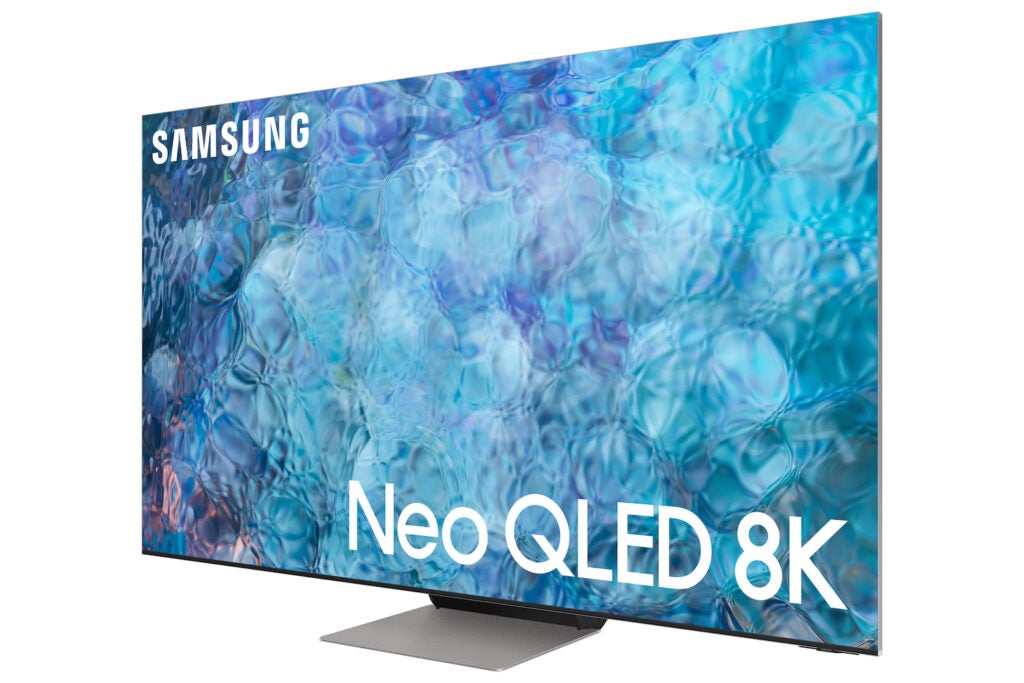
Samsung’s 2021 flagship is also markedly slimmer round the back than its 2020 predecessor, enhancing the ‘pictures from nowhere’ trick.
What chassis there is, though, is seriously pretty. The whole thing is wrapped in a gleaming metallic finish, with an attractive perforated edge to each side panel reminding us that, unusually, the 75QN900A carries speakers tucked inside. More on this later.
The huge screen sits on a surprisingly narrow, centrally mounted desktop stand, if you’re not wall-hanging it. This stand is supremely well built, and doesn’t at all feel like it will have any trouble handling the weight and size of the screen attached to it, despite how narrow it is.
The 75QN900A’s gorgeous minimalist design is completed by its total freedom from ugly cable spaghetti, thanks to an external One Connect box that can actually attach invisibly to the angled rear of the desktop stand. Even if you’d rather have the One Connect sat to the side of the TV for easier access, you’ll still only require a single cable to attach it to the screen.
Features
- Native 8K resolution
- Mini-LED technology with local dimming
- Object Tracking Sound system
Fittingly for a £6999 flagship TV, the 75QN900A is rammed with seriously cutting-edge features. Starting with the small matter of its ‘8K’ 7680 x 4320 pixel count.
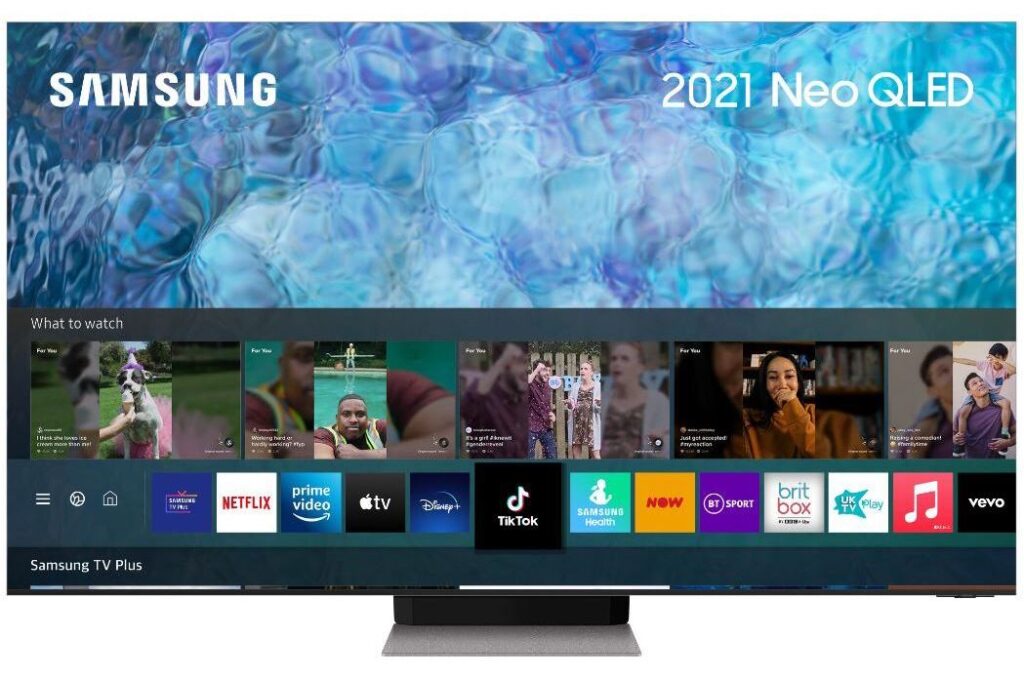
This fills the screen with four times as many pixels as a 4K TV. Cynics may question the point of this when the only native 8K source currently available in the consumer world is a small collection of YouTube videos.
However, we’ve already seen with previous generations of 8K TV from Samsung and others that the quality of upscaling processing nowadays – especially when backed up by ‘AI’ as it is on the QE75QN900A – can lead to 4K and even HD images looking better on an 8K screen. This is especially true when it comes to dots per inch density.
Samsung has actually greatly enhanced the power of its 2021 flagship AI upscaling system. Previously, the processing analysis and results Samsung’s 8K upscaling relied upon were drawn from the efforts of a single neural network. For the 75QN900A, however, the AI system has drawn its processing know-how from the combined analysis work of no less than 16 different neural networks.
Of course, there remains an outside shot that native 8K content will eventually start to appear in volume. And if/when that happens, only people with an 8K TV such as the QE75QN900A will be in a position to take advantage of it.
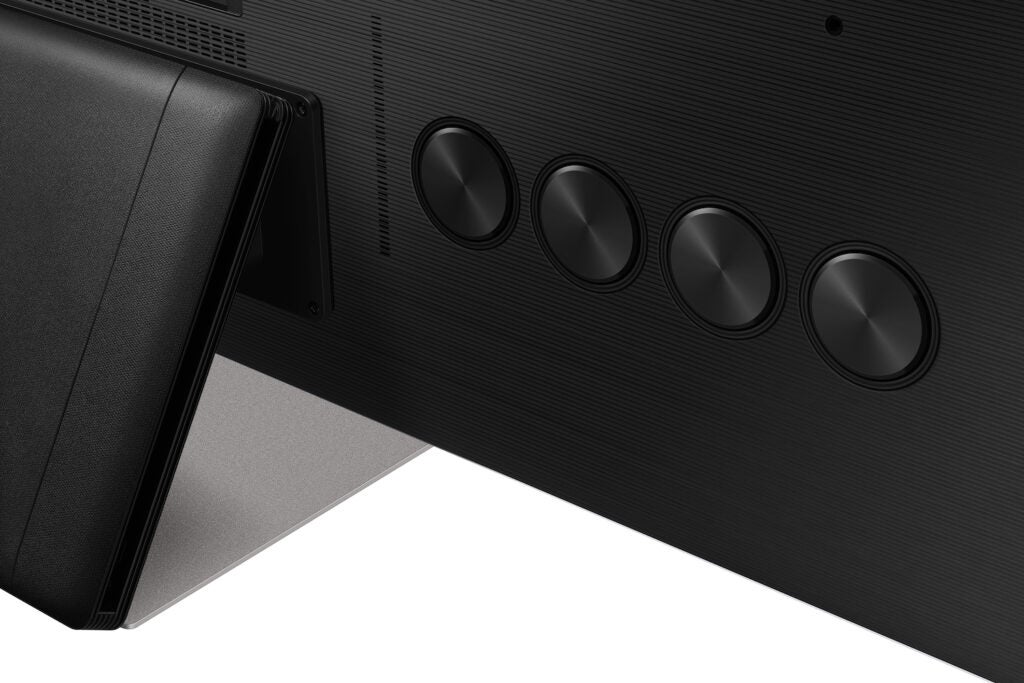
The 75QN900A’s adoption of mini-LED technology is arguably its most significant feature. This sees Samsung remove the lens and packaging that bulks up normal LEDs to fit many more smaller LEDs into the same screen space.
Samsung has then backed up this boost in LED numbers with an increase in the number of separately controlled dimming zones. The 4K 65QN95A upped the dimming zone count from around 480 to 792 on its non-mini LED processor. With the 75QN900A, though, Samsung goes dimming crazy with 1920 zones of LEDs able to output different amounts of light at any given moment.
Fans of OLED will be keen to point out that every single pixel in an OLED screen can deliver its own distinct light output. The big thing about the 75QN900A, though, is that it combines its vastly improved local light control with levels of brightness with which OLED can’t compete.
In fact, in its Dynamic picture preset the 75QN900A can fleetingly pump out a massive 4000 nits of brightness. This really does only last for a brief moment before the screen dims down to well under half that brightness, but it’s possible you really might momentarily see this sort of intensity in real-world content, where a seriously bright highlight only appears on-screen for an instant.
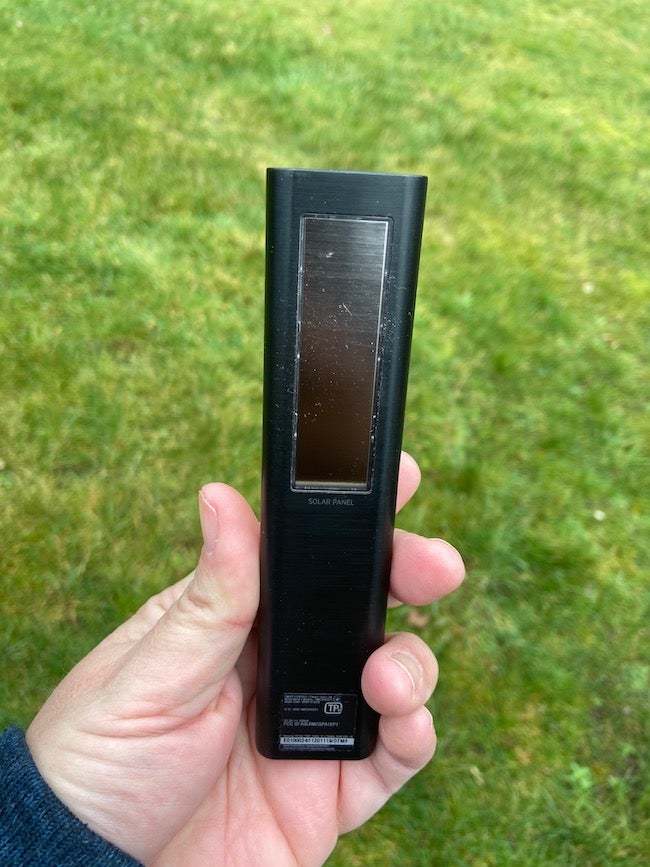
Even the more ‘stable’ Standard picture preset continues to deliver a sustained 1680 nits of light when measured on a white HDR window occupying 10% of an otherwise black screen. This is pretty much double the peak brightness that standard OLED technology can provide, and still the best part of 700 nits more than even the new generation of ‘high brightness’ OLED panels.
Regular readers will know that Samsung has hit 2000 nits or so of brightness in the past without mini-LED technology. The key point about mini-LED, though, is the ability it offers – in conjunction with the boost in the number of local dimming zones – to deliver high brightness without the sort of backlight ‘blooming’ around bright objects that’s usually such a headache for very bright LCD TVs.
All this brightness needs to be partnered with an advanced colour system if it isn’t going to bleach out colours. Cue QLED: the name now given to TVs that use quantum dot rather than colour filter technology to produce their colours. The quantum dot approach enables more precise colour tones to be produced across a wider colour volume. Especially when, as in the 75QN900A’s case, the QDs are encased in a metal shell so they can be driven harder.
As with Samsung’s previous few flagship LCD TV generations, the 75QN900A features wide viewing angle technology so that people who aren’t watching the TV from head-on don’t see as much colour and contrast reduction as they would with regular LCD TVs.
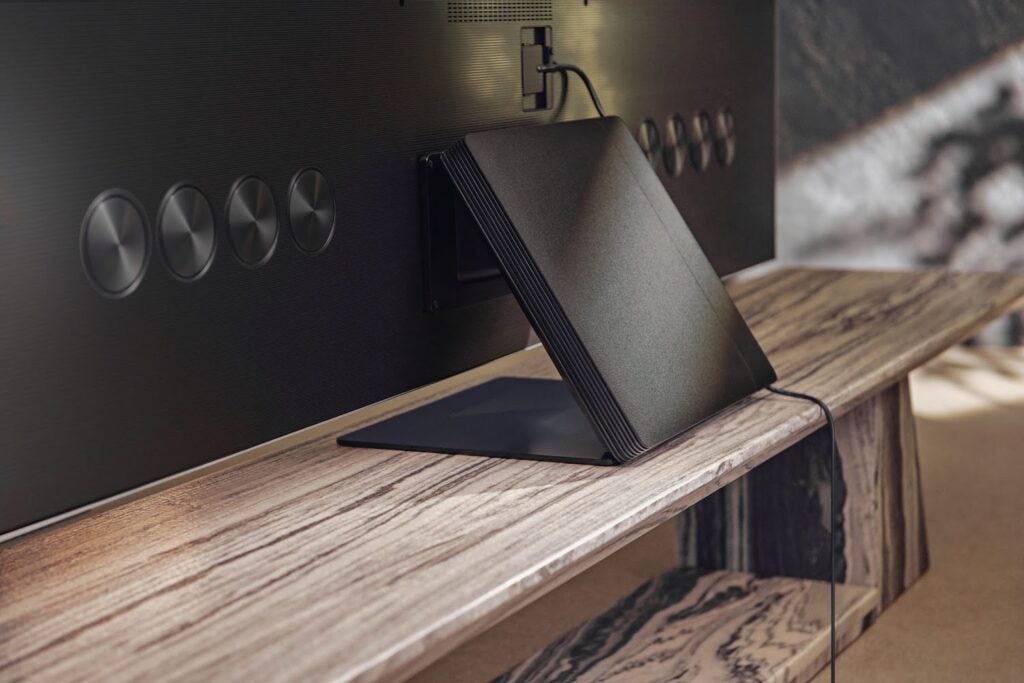
The 75QN900A’s connectivity is outstanding – chiefly because all four of its HDMIs are built to the latest HDMI 2.1 standard, with 40Gbps support. This means that all four can support cutting-edge gaming features – 4K at 120Hz, variable refresh rates and automatic low latency mode (ALLM) switching – introduced by the Xbox Series X and PS5 consoles, as well as the latest premium AMD and Nvidia PC cards.
In fact, the QE75QN900A can also support the AMD FreeSync Pro and Nvidia G-Sync variable refresh rate systems – although the latter is not officially supported.
When set to Game mode, the Samsung 75QN900A also gets the time it takes to reproduce game image data received at its inputs down to just under 10ms. Which is remarkably fast for any TV, never mind one that’s having to add tens of millions of pixels to even 4K sources.
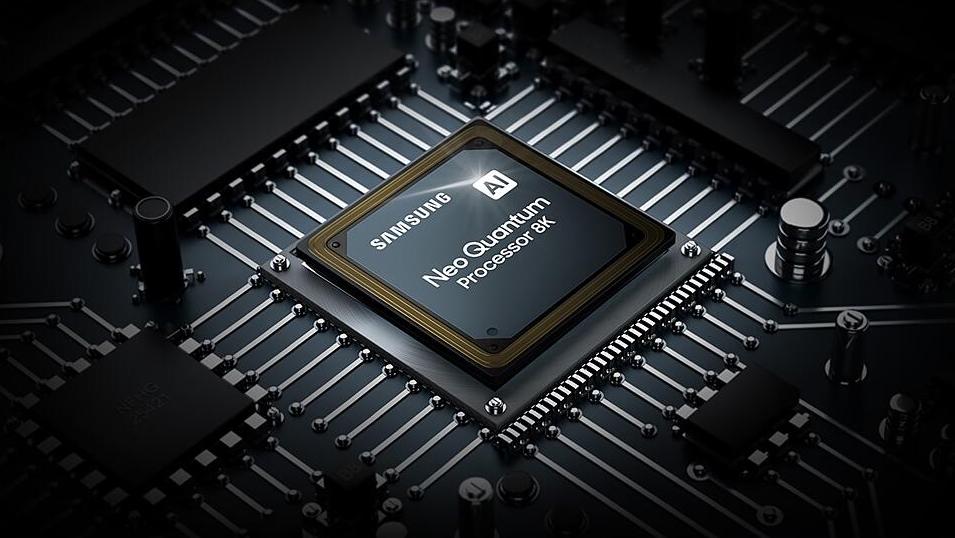
Samsung has introduced a new Game Bar, too, which handily provides an at-a-glance guide to the incoming graphics format and TV settings you’re using for your current gaming session.
The only glitch in the 75QN900A’s connectivity matrix comes with its HDR support. For while it supports HDR10 (as all HDR TVs must), the HLG live broadcast/stream HDR format, and the active HDR10+ format, it doesn’t cover the Dolby Vision format. This, like HDR10+, adds extra scene-by-scene image data, and is found on more sources than HDR10+. Including, now, the Xbox Series X, for both gaming and streaming services.
Finally, smart services are provided by Samsung’s Tizen-based Eden system. This is a strong effort in terms of both the range of apps it covers and its presentation. This helpfully uses content ‘shelves’ superimposed over the bottom of the image rather than a full-screen interface for its homescreen, and navigation is easy to follow. There are plenty of customisation options, too.
The only flaw is the lack of either Freeview Play or YouView apps for bringing all the catch-up services for the key UK terrestrial broadcasters under one umbrella app. All those UK catch-up apps are there in their individual forms, however.
Picture quality
- High peak brightness
- Bright image that also delivers deep black levels
- AI 8K upscaling technology
While we were impressed by the difference mini-LED technology made to the 65QN95A, we’ve had our tiny minds blown by the difference it makes on the 75QN900A.
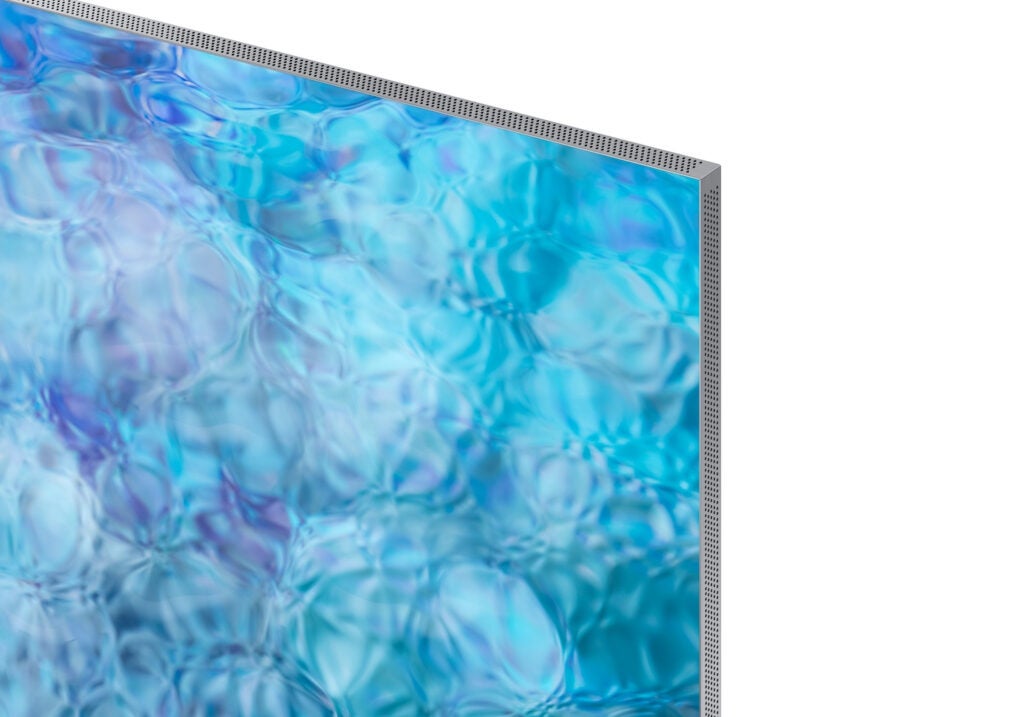
The massive increase in dimming zones is transformational. Dark scenes benefit from stunning black levels by LCD TV standards. They get so deep, in fact, that even in a blacked-out room you can often feel like you’re watching an OLED TV, not an LCD.
Except, that is, that the 75QN900A is capable of producing levels of brightness that no OLED TV can. Bright HDR imagery explodes off the screen, hitting with an impact that not only makes SDR look dead and buried, but also captures that ‘real life’ feeling that HDR is truly all about.
The 75QN900A noticeably improves on the colour performance of its predecessor, too, delivering a richer, more vibrant palette that keeps up with the screen’s brightness, rather than starting to look a little faded in the brightest areas.
The result is an eye-popping demonstration of what wide colour gamut in conjunction with HDR technology can do. Especially given that the 75QN900A’s new lighting engine means there’s far less chance than there has been on any previous Samsung TV for images that contain a mix of light and dark content to suffer with either backlight blooming/clouding, or extreme local dimming. Both of which can have an impact on colour tones.
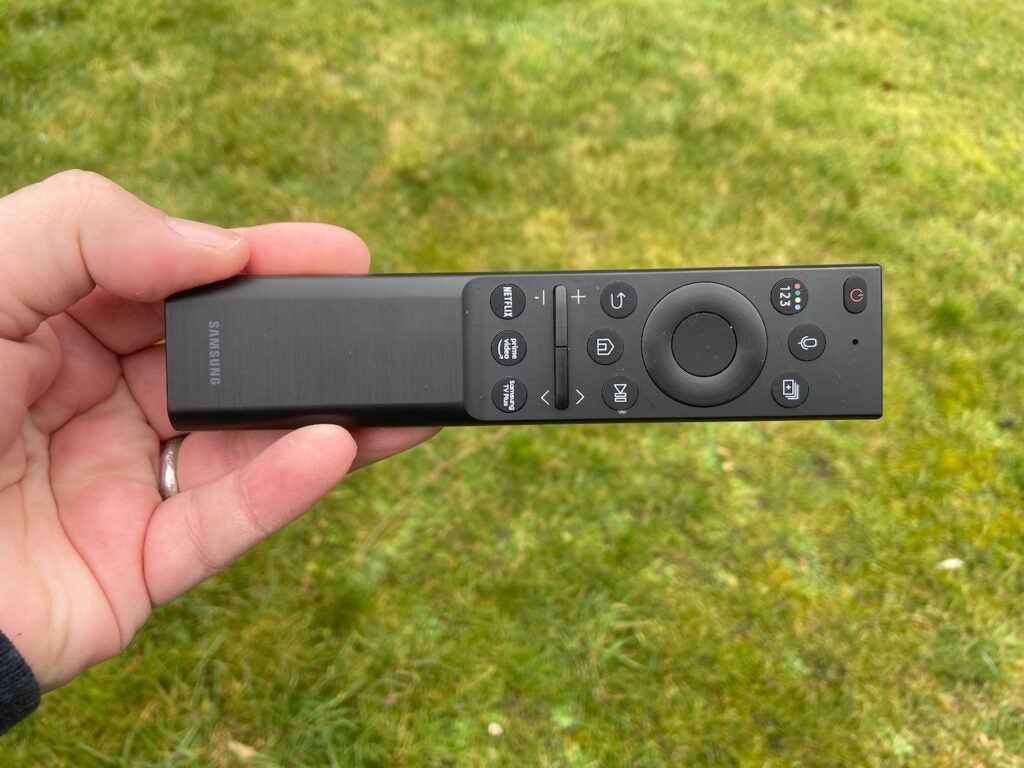
The 75QN900A’s mini-LED lighting and dimming system also tackles what has consistently been the biggest weakness of Samsung’s premium TVs. Previously, while Samsung has pretty much ruled the world when it comes to the depth and consistency of the black colours that premium LCD TVs can reproduce, it has had to severely dim down areas of brightness that stand out against very dark backgrounds.
Otherwise, they’d have caused pretty glaring light ‘halos’ around them. However, the combination of mini-LED lighting with nearly 2000 dimming zones means that all but the tiniest areas of peak brightness can retain almost full, uncompromised brightness – even when they appear against almost total blackness.
Samsung’s native 8K pictures look dazzlingly sharp, dense and textured, as well as enjoying an extra sense of three dimensionality and realism. Some will tell you that native 8K resolutions don’t matter until you get to really huge screens of almost 90 inches and more, but the difference at 75 inches seems clear to me – even if it makes its presence felt in more subtle ways than mere ‘sharpness’.
Arguably more importantly, given the lack of 8K content, the 75QN900A’s upscaling noticeably improves over the already excellent efforts of Samsung’s 2020 8K sets. Upscaled 4K sources look even cleaner and sharper, as well as containing a greater sense of depth than the same sources enjoy on most native 4K TVs.
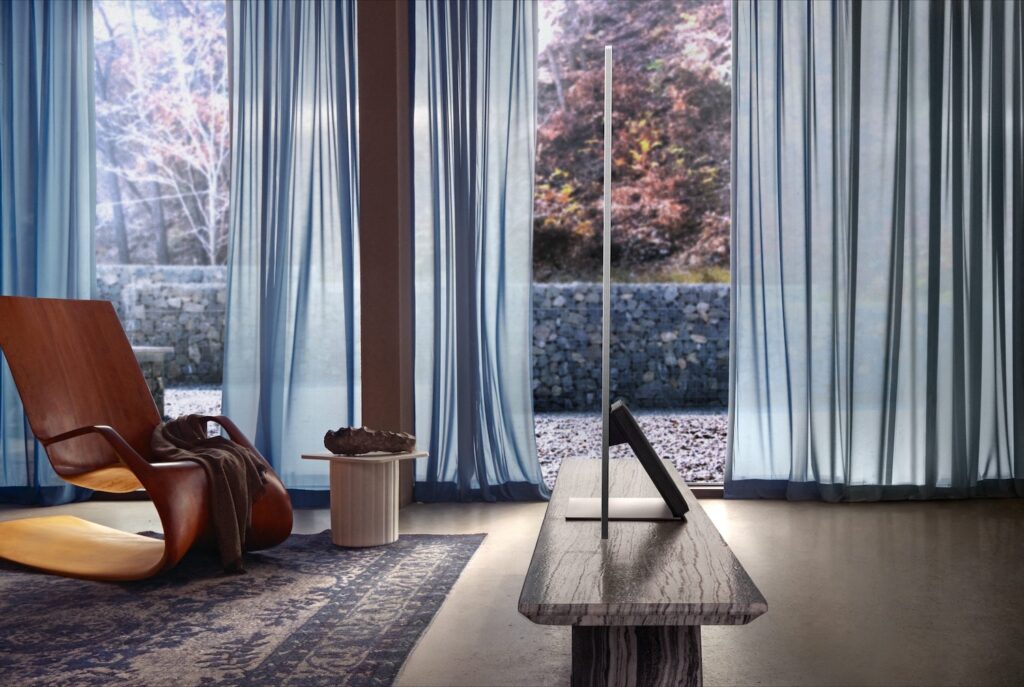
The input of all the extra neural networks Samsung has deployed in developing its 2021 AI processing has even more impact on upscaled HD sources, which look both far sharper and far cleaner (less affected by source noise) than they did on last year’s 8K models. The results are never less than watchable, even with heavily compressed digital sources, and can even look genuinely enjoyable with good-quality HD sources.
The sharpness holds up well during camera pans and over fast-moving objects, too. Just make sure that you don’t stick with the 75QN900A’s default Auto Picture Clarity settings, however. The motion processing in this Auto mode is too heavy-handed, causing lots of digital side effects that are actually far more distracting than a bit of judder. Choose the Custom motion setting and judder and blur values of around three or four to get the most natural results.
The 75QN900A doesn’t just dazzle with movie and TV content. It’s also a formidable gaming display. Native 4K and 120Hz titles look pin-sharp and effortlessly smooth. The screen handles variable refresh rates immaculately across all the current VRR formats, and lag is so low it’s essentially insignificant. The ALLM switching works perfectly with the Xbox Series X, too.
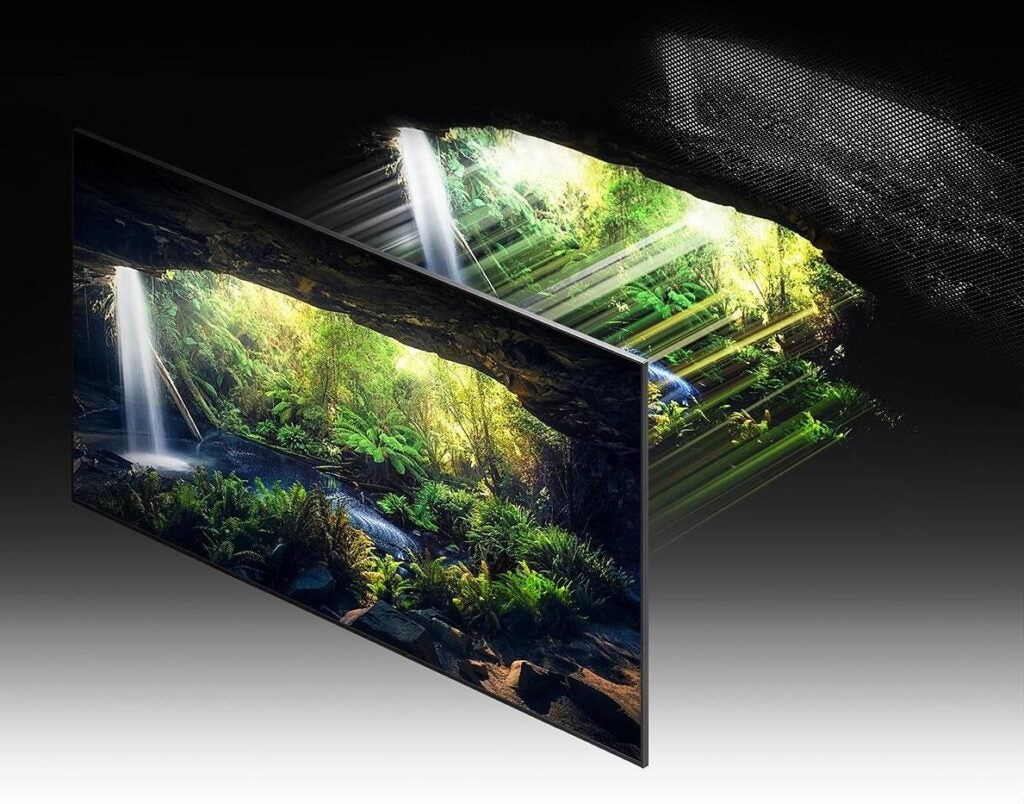
separate dimming zones.
Its big jump in dimming zones means the 75QN900A doesn’t suffer as much – or at all, really – with backlight blooming/haloing when gaming as the 65QN95A. Plus, its brightness adds a gorgeous extra sense of realism to strong HDR titles such as Call Of Duty Black Ops: Cold War.
As noted with the 65QN95A, for me, the default FreeSync Pro settings don’t get the best out of the 75QN900A’s pictures. Nevertheless, it’s easy enough to tweak the colour and backlight settings without losing FreeSync Pro’s VRR talents.
While the 75QN900A’s pictures are for the most part ground-breakingly stellar, they aren’t quite perfect. In particular, while the mini-LED lighting and generous number of dimming zones has had a significant impact on the TV’s consistent handling of bright highlights, there’s still a size factor in play. So where a bright highlight is really small, the TV still has to reduce its intensity quite substantially to keep backlight blooming at bay. This is a rare reminder that even nearly 2000 dimming zones isn’t the same as the pixel-level lighting of OLED technology.
Next, while backlight blooming is almost a non-issue when viewing the 75QN900A straight on, it can start to rear its head when you’re viewing from an angle.
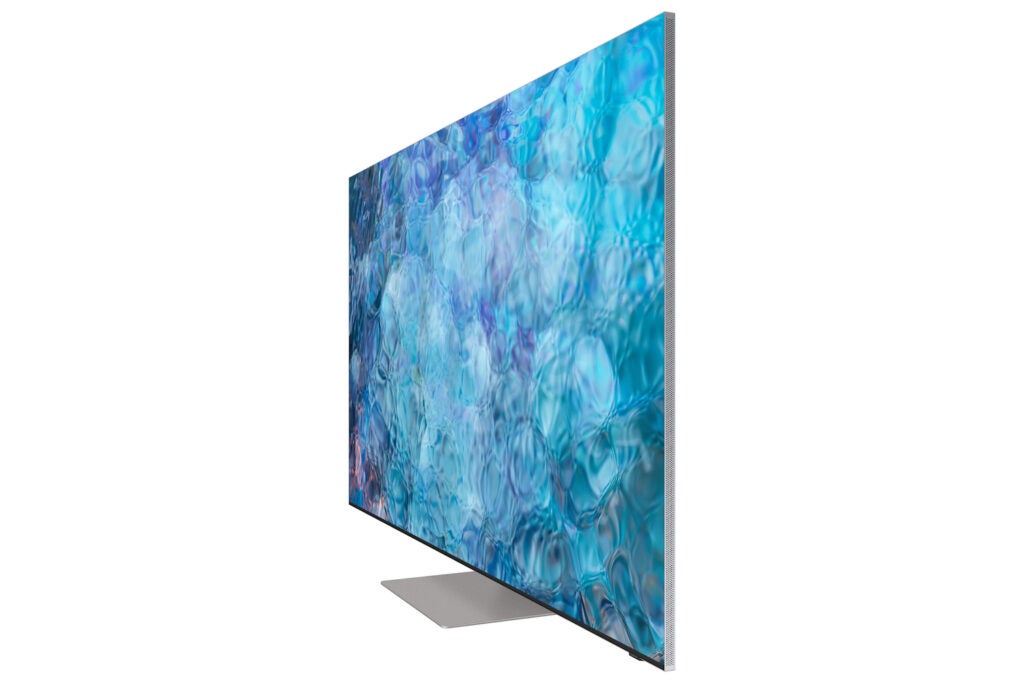
Rich reds can take on a pinkish tone from time to time, too, and while the Standard picture preset generally delivers the most satisfying and exciting results overall, it can crush a little shadow detail out of very dark scenes.
Given how stellar the 75QN900A looks with HDR, we can’t help but wish we were able to see how it might handle the Dolby Vision format – although Samsung’s own dynamic tone mapping is undeniably impressive.
Ovreall, though, none of the niggles prevent the 75QN900A from being a dazzling exhibition of where TV picture quality is at in 2021.
Sound quality
- Wide sound stage
- Clear dialogue
- Speakers could be a little louder
While the 75QN900A’s audio system is clever, it isn’t as out-there amazing as its pictures. Some aspects work very well; the way the OTS+ system places sound in the correct part of the screen – even tracking moving objects – is remarkable, instantly making the sound more compelling and immersive.
The large number of speakers also creates a super-wide sound stage, casting sound well beyond the confines of the TV’s super-skinny frame in all directions. And it does this without any elements of the sound becoming baggy or dislocated.
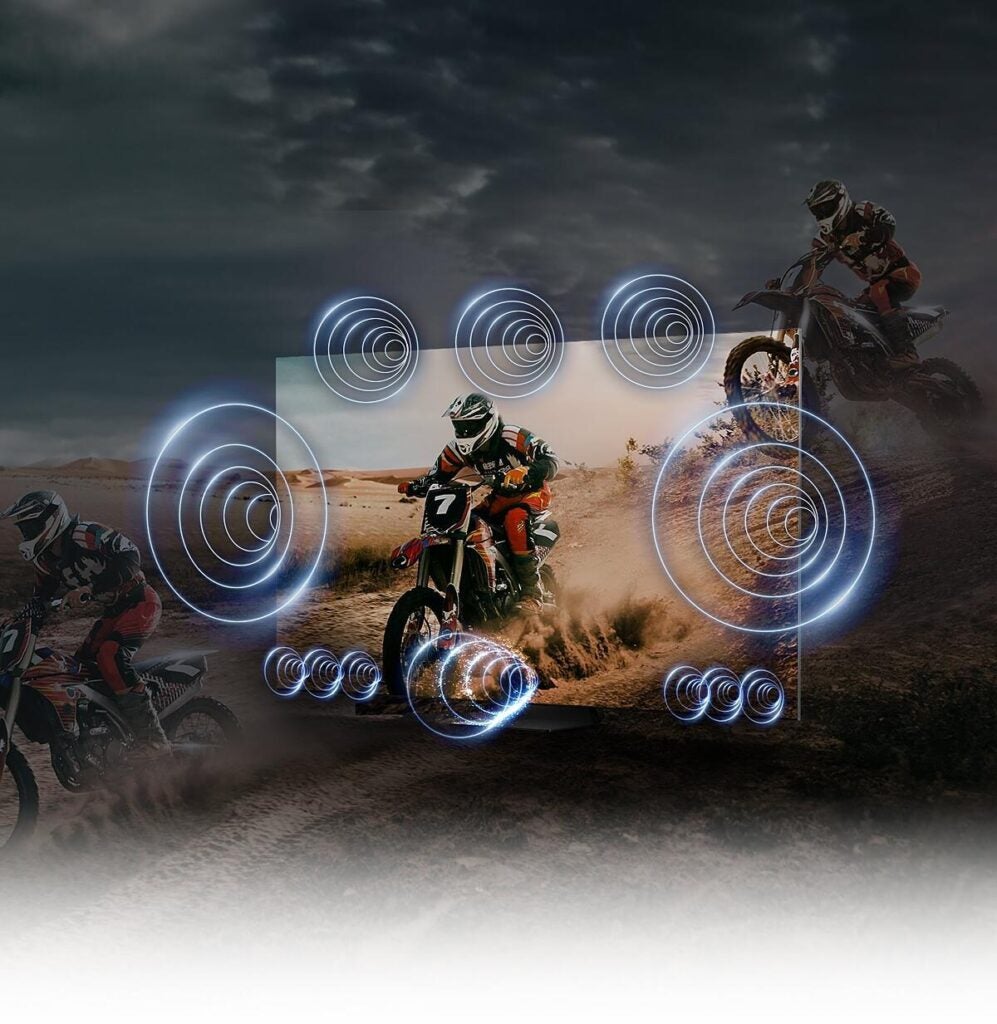
Dialogue is consistently clear and has its on-screen positioning bolstered by the OTS+ Surround system, too.
Surprisingly, considering the number of drivers it carries – there’s even a formidable roster of eight mid-range/low-frequency drivers facing out from the 75QN900A’s rear to go with the speakers built into the set’s barely there frame – Samsung’s 8K set doesn’t deliver particularly deep or powerful bass. In addition, the sound struggles to project forward into your room, often leaving the sound stage feeling as if it’s behind the TV rather than in front of it.
Neither do the 75QN900A’s speakers go quite as loud as you might hope for in a TV with such large, cinematic pictures. These various issues add up to a dynamic range that sometimes feels hemmed in versus the best sounding TVs out there.
I should stress that the 75QN900A’s sound is still good by the standards of the TV world at large, however. It’s worth mentioning, too, that thanks to Samsung’s Q Symphony feature, you can partner the TV’s speakers with a compatible Samsung soundbar to surprisingly good effect.
Should you buy it?
You want the most spectacular HDR pictures around The 75QN900A’s combination of mini-LED lighting, QLED colour and extreme local dimming help it get massive impact from today’s HDR picture technology.
You’re not feeling flush or you really want Dolby Vision At the best part of £7K, the 75QN900A will simply be beyond the budget of many buyers. And it’s a shame Samsung still doesn’t support the Dolby Vision HDR format.
Final Thoughts
If you’re financially able to see past the 75QN900A’s hefty price of entry, Samsung’s latest flagship 75-inch TV sets the pulse racing from the off with its stellar build quality and spectacular borderless design. And things only get better once you switch it on.
How we test
We test every TV we review thoroughly over an extended period of time. We use industry standard tests to compare features properly. We’ll always tell you what we find. We never, ever, accept money to review a product.
FAQs
It uses new mini-LED lighting, backed up by QLED colour technology and 1920 separately controllable local dimming zones.
This is an 8K TV, meaning it has 7680 x 4320 pixels (four times as many as a 4K TV).
Samsung has placed the connections on an external box that connects to the TV via a single cable, to reduce the amount of cabling you have to attach directly to the TV. You can also attach the One Connect to the neck of the TV’s desktop stand, so it becomes invisible too.
4K at 120Hz, variable refresh rates using the AMD FreeSync Pro, Nvidia G-Sync and standard HDMI varieties, plus ALLM (automatic low latency mode) switching.







